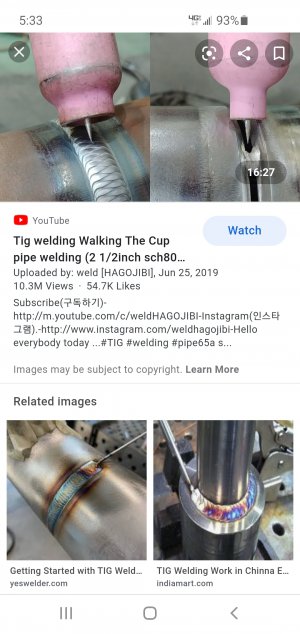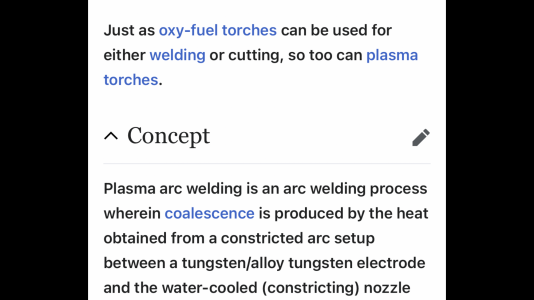- Joined
- Feb 13, 2017
- Messages
- 2,138
Perhaps it should be a hypothetical question about theory. Call it what you will, I've a curious idea and look to the combined resources of the group for possibile answers. The background of the theory is a TIG welder and a Plasma Torch. I have acquired a Plasma Torch for "future" use. I've never plugged it in, never even removed it from the shipping box. I opened it to look for shipping damage, but without material or projects, it isn't currently needed.
I do know how to "stick" weld, the old timer that taught me could write his name on sheet metal building siding without blowing a hole. I'm not that good, but do know how to stick two pieces of metal together well enough to climb on. A few years back, I rebuilt a John Deere 54 inch mower deck, welding on a new top plate. The bearing housings were home made and I had a real welder at the mill to weld the pieces together. Too cheap to buy real JD bearings. . . My welder is a Lincoln AC-225 "farm" welder that has been converted to DC with a full wave bridge.
The Plasma Torch is essentially a carbon electrode, like a gouge rod of sorts. The idea is to draw an arc and when the metal is hot enough, a stream of gas blows the molten metal out. The gas is optimally Argon, perhaps Nitrogen or CO2. The low end torch I acquired can even use compressed air. A dryer and regulator are onboard the welder, in addition to the usual paraphanlia on the combressor itself.
I know how to use an OA torch, having done so many times over the years. My Oxy tank is out of date by many years and I'm too cheap to refill it until I really need it. Which isn't likely at this point. The burning torch is the smallest that Victor offers, as are the welding tips. The Plasma Torch was cheaper than getting my O2 tank hydro tested. And I'm about out of Acet, also out of date.
The TIG welder, to my understanding, has a carbon electrode to draw the arc, surrounded by an inert gas. The intensity of the arc is of lower intensity to avoid punching a hole in the work. A filler rod is fed into the "puddle" from outside. I have seen TIG results, but never the process of actually welding. Or seen the tip. . .
The idea /theory /question /thought is that a Plasma Torch has the essential structure for TIG welding. With a flow regulator on an inert gas to keep the flow very low, and the arc current down very low to melt without "melting through", what else is necessary to TIG weld? Keep in mind, I do not do welding commercially and work with relatively small parts. I have a "small" tractor, 30 HP. And a 1 ton dump truck. Any welding on those would be done with a stick welder. The bearing housings on the JD mower deck would have been TIG welded had I the knowledge and equipment at the time. Those would be about the largest work I would want to TIG.
Any insights /thoughts /ideas will be most welcome. I will be off line for a couple of days, so answers well thought through will be optimal.
I do know how to "stick" weld, the old timer that taught me could write his name on sheet metal building siding without blowing a hole. I'm not that good, but do know how to stick two pieces of metal together well enough to climb on. A few years back, I rebuilt a John Deere 54 inch mower deck, welding on a new top plate. The bearing housings were home made and I had a real welder at the mill to weld the pieces together. Too cheap to buy real JD bearings. . . My welder is a Lincoln AC-225 "farm" welder that has been converted to DC with a full wave bridge.
The Plasma Torch is essentially a carbon electrode, like a gouge rod of sorts. The idea is to draw an arc and when the metal is hot enough, a stream of gas blows the molten metal out. The gas is optimally Argon, perhaps Nitrogen or CO2. The low end torch I acquired can even use compressed air. A dryer and regulator are onboard the welder, in addition to the usual paraphanlia on the combressor itself.
I know how to use an OA torch, having done so many times over the years. My Oxy tank is out of date by many years and I'm too cheap to refill it until I really need it. Which isn't likely at this point. The burning torch is the smallest that Victor offers, as are the welding tips. The Plasma Torch was cheaper than getting my O2 tank hydro tested. And I'm about out of Acet, also out of date.
The TIG welder, to my understanding, has a carbon electrode to draw the arc, surrounded by an inert gas. The intensity of the arc is of lower intensity to avoid punching a hole in the work. A filler rod is fed into the "puddle" from outside. I have seen TIG results, but never the process of actually welding. Or seen the tip. . .
The idea /theory /question /thought is that a Plasma Torch has the essential structure for TIG welding. With a flow regulator on an inert gas to keep the flow very low, and the arc current down very low to melt without "melting through", what else is necessary to TIG weld? Keep in mind, I do not do welding commercially and work with relatively small parts. I have a "small" tractor, 30 HP. And a 1 ton dump truck. Any welding on those would be done with a stick welder. The bearing housings on the JD mower deck would have been TIG welded had I the knowledge and equipment at the time. Those would be about the largest work I would want to TIG.
Any insights /thoughts /ideas will be most welcome. I will be off line for a couple of days, so answers well thought through will be optimal.
Bill Hudson





